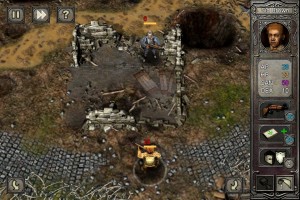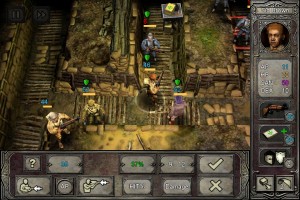(Editor’s Note: What follows is the original review written for the first version the author played, and our site score also reflects the state of the game at that time. Since then, one or more major critiques have been addressed by the developer. For a list of these, see “Addendums” below the original review score at the end of the article.)
The concept of a Turn-Based Strategy game set in the context of H.P. Lovecraft’s Cthulhu mythos has “win” written all over it, so there’s no doubt in my mind Red Wasp Design is right to take a stab at it with Call of Cthulhu: The Wasted Land (Out Now, $4.99). Purists may cry foul at the way Wasted Land’s plot appears to inject Cthulhu into Lovecraft’s earlier and only partially related story “Herbert West: Reanimator,” but the benefits are obvious from a game design perspective: you get Cthulhu, zombies, semi-automatics and messy World War I battlefields all in one package!
 That last part holds immense potential in a genre where terrain effects have proven difficult to tie into gameplay as strongly as they probably should be. In Wasted Land, terrain effects finally get their due. The player directs a growing platoon through all the trenches and ruins one should expect in a proper no man’s land, evading mustard gas clouds, taking shelter in craters, and summoning artillery as needed. If an enemy hides behind the twisted husk of a tree you’ll have to displace a few units to re-acquire line of sight. The game’s Action Points system seems tailor-made for having a character go “over the top,” take a pot shot, then dip back into a trench, all in the same turn. There are plenty of occasions where you can target enemies at unrealistic angles, but Wasted Land still gets enough use out of the line-of-sight concept that it might just qualify as a rare TBS/cover shooter mashup.
That last part holds immense potential in a genre where terrain effects have proven difficult to tie into gameplay as strongly as they probably should be. In Wasted Land, terrain effects finally get their due. The player directs a growing platoon through all the trenches and ruins one should expect in a proper no man’s land, evading mustard gas clouds, taking shelter in craters, and summoning artillery as needed. If an enemy hides behind the twisted husk of a tree you’ll have to displace a few units to re-acquire line of sight. The game’s Action Points system seems tailor-made for having a character go “over the top,” take a pot shot, then dip back into a trench, all in the same turn. There are plenty of occasions where you can target enemies at unrealistic angles, but Wasted Land still gets enough use out of the line-of-sight concept that it might just qualify as a rare TBS/cover shooter mashup.
Wasted Land also impresses in the way it gives the player control over the development of units. A soldier might specialize in a particular weapon type – shotguns, pistols, rifles and melee options are all on tap – and therein gain accuracy bonuses when appropriately equipped. That same soldier could just as easily be diverted into the role of combat medic, and there are miscellaneous stats to develop in addition. Characters gradually rack up skill with their currently equipped weapon type as they use it in battle, but their stats are also governed by the player’s upgrade decisions between missions.
 So far, so good. If you’re playing on one of the small iDevices, however, an unsettling feeling will no doubt creep into the back of your mind as you work your way through Wasted Land’s first mission. No, it’s not Cthulhu whispering into your subconscious from his undersea dwelling — it’s the fact that the game’s interface isn’t doing half of what you’re asking! The developer made an admirable attempt to design a streamlined, tap-heavy UI, but it completely blew up on the smaller touchscreens. Simply put, Wasted Land is flummoxed by the most unresponsive controls I’ve encountered as a reviewer.
So far, so good. If you’re playing on one of the small iDevices, however, an unsettling feeling will no doubt creep into the back of your mind as you work your way through Wasted Land’s first mission. No, it’s not Cthulhu whispering into your subconscious from his undersea dwelling — it’s the fact that the game’s interface isn’t doing half of what you’re asking! The developer made an admirable attempt to design a streamlined, tap-heavy UI, but it completely blew up on the smaller touchscreens. Simply put, Wasted Land is flummoxed by the most unresponsive controls I’ve encountered as a reviewer.
I think the problem can be traced to woefully small touch areas on units and targets. To give you an idea of just how under-sized the touch response areas are, I dipped into the game again just now and failed six times in a row to select a target before the seventh double-tap finally did the trick. The game sometimes interprets a failed double-tap as a single tap on the target, which brings up the target’s stats panel and removes control over the character the player had been trying to direct. Choosing destination squares and pushing menu confirmations through can be equally dicey. While I claim fairly that I spent half my time with the game fighting enemies and half fighting the controls, it’s worth noting that it’s easy to see where Wasted Land might fare tons better on the iPad’s larger screen area. The iPhone or iPod Touch owner, on the other hand, would do well to steer clear until the developer can roll out the adjustments needed to make Wasted Land playable on a small touchscreen.
 A few questionable gameplay quirks have also made it into Wasted Land, and while these don’t sit well with the TBS fan in me, your own mileage may vary. The first thing you’ll notice is that a unit’s movement range is invisible until the player taps somewhere on the battlefield. While this keeps the field visually uncluttered, it goes against the grain of Wasted Land’s otherwise streamlined approach by making the player take a shot in the dark before finding out where the selected character can actually move. That issue is tolerable enough in my book, but here’s the real kicker: Wasted Land starts all the player characters off un-specialized in their default weaponry, which means none of them can hit the broad side of a barn door at first. The first battle is still even because enemies have just as difficult a time hitting the mark, but you can imagine how this makes for an introductory stage that drags on far longer than could possibly be justified. Re-defining what it means to be a novice gunner might be well worth the developer’s while in updates.
A few questionable gameplay quirks have also made it into Wasted Land, and while these don’t sit well with the TBS fan in me, your own mileage may vary. The first thing you’ll notice is that a unit’s movement range is invisible until the player taps somewhere on the battlefield. While this keeps the field visually uncluttered, it goes against the grain of Wasted Land’s otherwise streamlined approach by making the player take a shot in the dark before finding out where the selected character can actually move. That issue is tolerable enough in my book, but here’s the real kicker: Wasted Land starts all the player characters off un-specialized in their default weaponry, which means none of them can hit the broad side of a barn door at first. The first battle is still even because enemies have just as difficult a time hitting the mark, but you can imagine how this makes for an introductory stage that drags on far longer than could possibly be justified. Re-defining what it means to be a novice gunner might be well worth the developer’s while in updates.
Wasted Land sports crisp character models and superbly polished environments. The game got my hopes up on the musical front. It ushers the player in with a deliciously horrific title theme, apparently a happy-go-lucky song from the early 20th century warped into something positively sinister with a little tonal alteration. Mission descriptions and character management screens are equally imbued with evil ambiance, but sadly the player will spend most of the game listening to battlefield sounds unaccompanied by music.
iFanzine Verdict: Frightfully unresponsive controls sap Call of Cthulhu: The Wasted Land of all appeal it might have enjoyed on the iPhone and iPod Touch. If its interface gets the sensitivity overhaul it badly needs, it will hopefully be remembered for its cool premise and creative use of terrain; those rare occasions when you’re lucky enough to hit the right touch areas offer glimpses of an enjoyable TBS.
Addendum: Much improved interface.

